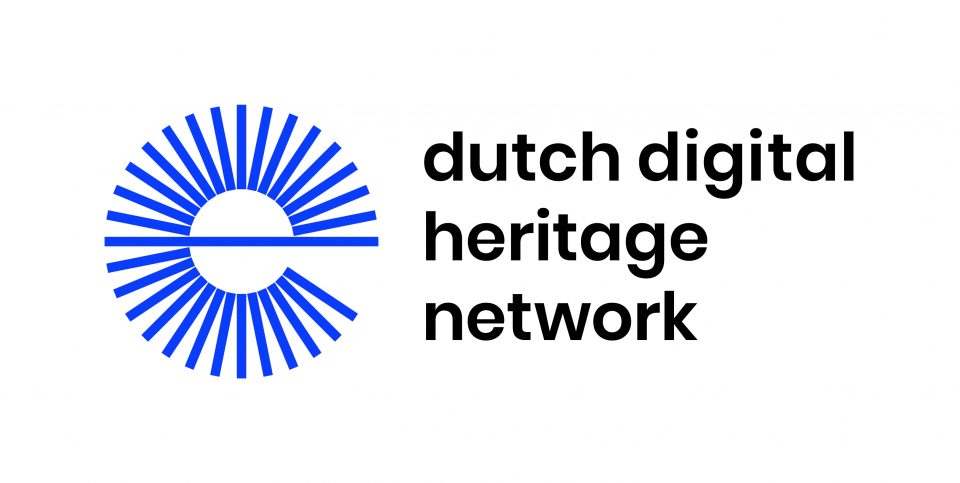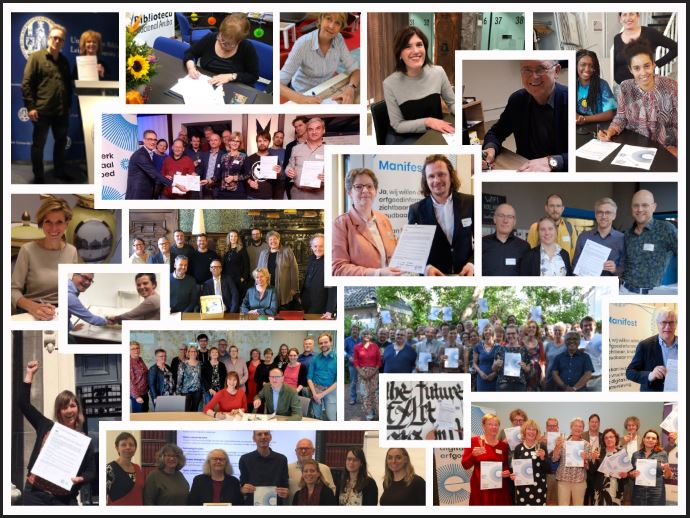 The strength of a Network lies in the network itself. Dozens of heritage institutions, research institutes, partnerships and knowledge organisations from various domains in the Netherlands are currently collaborating in the Dutch Digital Heritage Network (DDHN) to set up a system of national facilities to make our digital memory more visible, usable and sustainable. This partnership network is open to all interested organisations across the entire heritage and research field. As the DDHN is a network, there is no legal status and no membership fee involved. Institute participation is based on taking responsibilities and becoming part of an national movement.
The strength of a Network lies in the network itself. Dozens of heritage institutions, research institutes, partnerships and knowledge organisations from various domains in the Netherlands are currently collaborating in the Dutch Digital Heritage Network (DDHN) to set up a system of national facilities to make our digital memory more visible, usable and sustainable. This partnership network is open to all interested organisations across the entire heritage and research field. As the DDHN is a network, there is no legal status and no membership fee involved. Institute participation is based on taking responsibilities and becoming part of an national movement.
The DDHN has been on the road for a few years. Since 2019 we accelerated the activities, made possible by the Ministry of Education, Culture and Science (OCW) having made extra funding available for the years 2019 and 2020. During this period, we are tasked with “intensifying the services and the inclusivity of the Digital Heritage Network”. At the heart of the assignment lies the sustainable accessibility of heritage collections, particularly including those of smaller institutions.
The intensification comes at the right time. The network has a stable foundation and we have developed a number of useful practical facilities. Many heritage organisations are already working on preserving the availability of their digital collections. In the period 2019 and 2020 we intensified these efforts with a range of activities, which fall under two main pillars:
- Developing generic facilities for visible, usable and sustainable heritage
- Build capacity and foster knowledge exchange the various field of expertise related to the national strategy in order to raise knowledge
Apart from these two pillars, we also defined the basic principles to ensure that the results are of added value to the network. Each outcome should therefore:
- Concern collaborations in which several institutions are involved.
- Be demonstrably cross-sectoral and contribute to the development of a network of shared facilities.
- Increase the sustainable access to digital collections in the Netherlands and focus on specific issues.
- Arrange agreementsabout the actual use and management (exploitation) of results.
- Pay attention to the wide dissemination and exchange of knowledge.
The network originally came forth out of the Dutch Coalition for Digital Preservation (NCDD) which has a strong focus on sustainability of our digital heritage. But since 2015 two other elements were defined equally important as preserved heritage is only of value if it can be found and used by the public, researchers, archivists and many other communities. Therefore, the visibility of collections and its usability are new perspectives taken into account. This means that there is not a collaborative network focusing solely on digital preservation in The Netherlands anymore. However, Digital Preservation has been placed in a much broader perspective, as the long-term usability and visibility are strongly attached with the preservation of digital collections.
In 2019-2020 the network was able to build on the roadmap defined in the national strategy for digital heritage. This has resulted in almost 50 Dutch institutes having signed the DDHN Manifesto. Being part of the Digital Heritage Network means working according to certain principles and a shift from “institutional thinking” to “network thinking”. A growing number of organisations from the heritage sector support this approach and believe that we can only get the most out of digital heritage if we work together.
With the additional funding from the Government the network was also able to intensify the development of collaborative services as has been started in 2015. Whereas the development of digital preservation services started by the NCDD years before and are based on the award winning project “constructing a Network of National facilities together”.
Some of the key results focusing on preservation services are:
- A national approach for the implementation of persistent identifiers for heritage institutes. This approach is based on collaboration with software vendors to implement of PID-services in their collection management systems and make these services available for their customers. www.pidwijzer.nl
- In 2019 we added up to the software vendor implementation approach for PID’s a similar approach for implementing Linked Data output from collection management systems
- A generic Cost model for calculating the preservation of digital collections based on the 4C model and the CCeX.
- This model has recently combined with the NCDD-model for shared facilities and preservation policies. The result is described in the white paper “The Big Picture of digital preservation” in which the connection between policies, infrastructure and costs are described as a method to make choices in a preservation approach infrastructure and costs are described as a method to make choices in a preservation approach.
- A guidance for developing preservation policies, based on the SCAPE preservation policy elements
- A collaborative register of archived websites across the Netherlands
- A guidance for certification towards Core Trust Seal
- A Virtual Research Environment for digital preservation tools, in cooperation with the Open Preservation Foundation (OPF)
- Nationwide insight into the state of preservation of digital information stored on volatile media (CDs, DVDs, tape, magnetic disk). Based on these insights, the DDHN is developing a Risk Map to be added to the Bit-List of digitally endangered species and two or three generic work stations for creating disk images from their volatile media to be used by heritage institutes.
All these services developed within the framework of the DDHN will be managed by the partners within the Network from 2021 onwards. These partners, like the National Library and the Netherlands Institute for Sound and Vision will manage and promote services for all heritage institutes in the Netherlands, across domains. This is the best guarantee that services are sustainable for the long term. A general Toolbox will help users to find the services they need for their purposes and takes care for the connections between services.
With regards to the 2nd pillar of the programme, the DDHN developed several activities to promote the use of digital collections and to raise knowledge and expertise. Some examples are:
- The digital preservation training course and 2018 award finalist, Leren Preserveren
- Several Self-assessment tools to be used by heritage institutes to test themselves on their levels of maturity related to preserving digital collections, publishing of collections via Linked Data methods, knowledge of the public and communities and a general self-assessment on the three layers of the national strategy for digital heritage (visibility, usability and sustainability)
- A program of “erfgoedcoaches” (heritage coaches): experts on different fields based in the 12 Provinces of The Netherlands who help small scale institutes in translating nationwide activities into smaller regional practice. These Heritage coaches are funded by the DDHN-programme, but employed regionally to bring expertise closer to regional communities.
- A national campaign to promote digital heritage and the use of digital heritage on a national scale
- Several DDHN project published low-level YouTube video explanations of concepts and approaches. About Persistent Identifiers, WebArchiving, and very recently about the power of Linked Data.
The DDHN succeeded in realizing a strong cooperation in and between all domains (libraries, archives, museums, education). The network boosted relationships and is the driving force for collaboration. An example of this is the COVID-19 collection initiative, a call to action from the DDHN towards all heritage institutes in The Netherlands. Being a collaborative network, the DDHN was able to set up coordination of collection building. This means: advising institutes on approaches and tools, publishing best-practices and organizing a weekly Q&A on social media archiving. This is an example of how a network of institutes, with some coordination on top of it can do much more than individual institutes.
Another example is the approach on publishing collections and collection data using Linked Data principles and Persistent Identifiers. Individual institutes will never be able to force vendors to implement PID and LOD modules in Collection Management Systems. Many institutes working together in a network are able to reach this. The DDHN is working together with software vendors and heritage institutes to build a network of collections and terminology resources based on PID and Linked Data principles.
By doing this preservation of digital resources is directly attached to the usability and the (long-term) findability and visibility of heritage resources, showing the importance ofpreserving digital records.































































































































